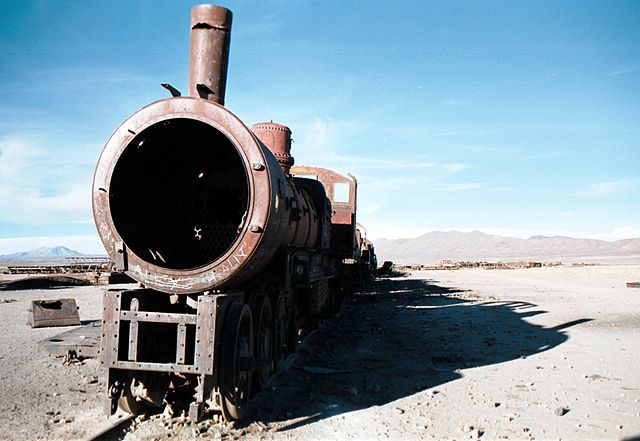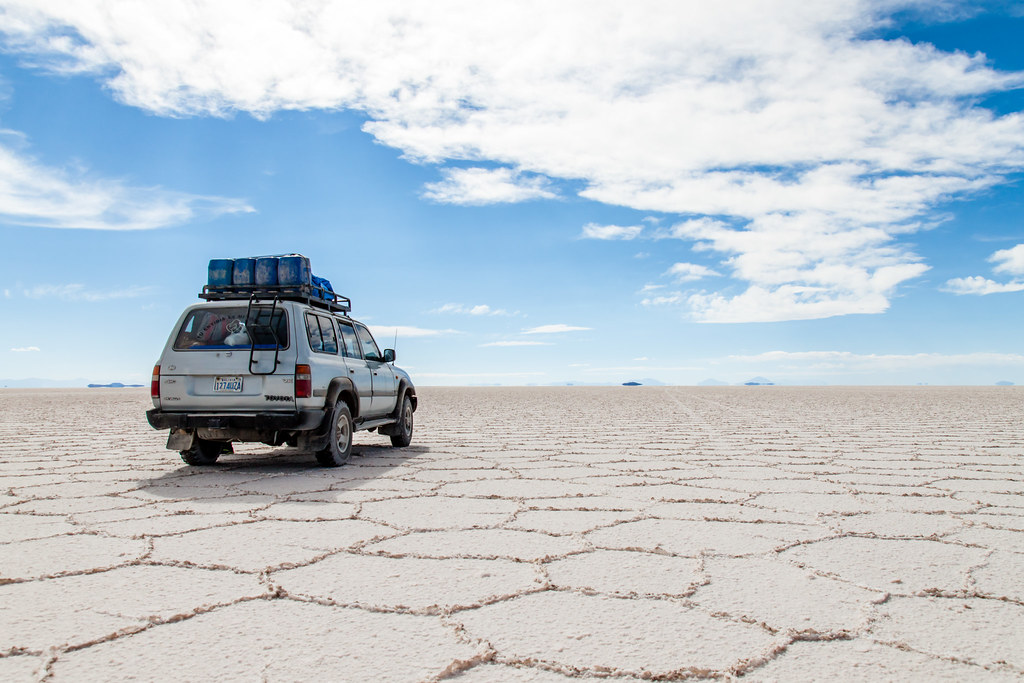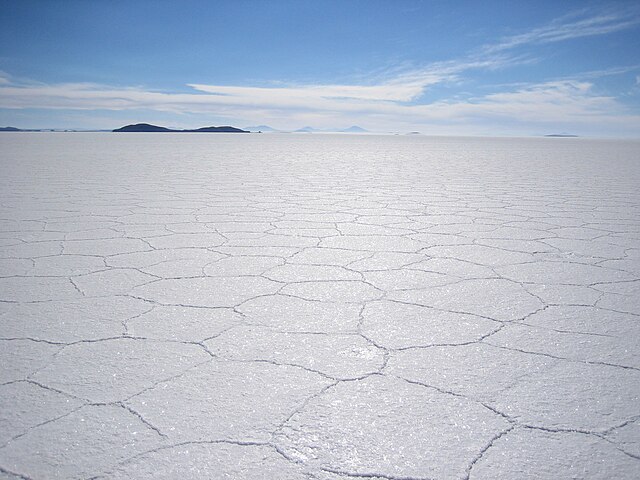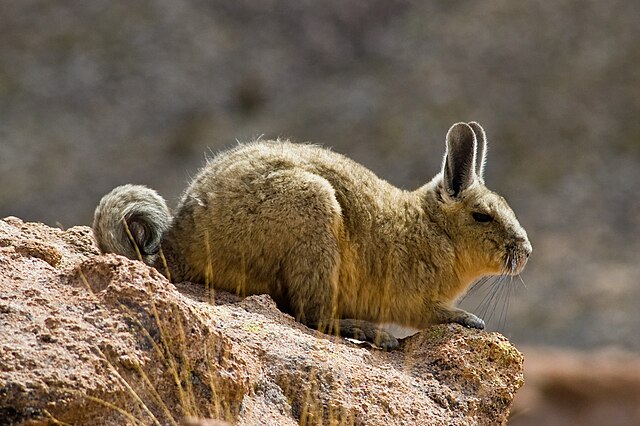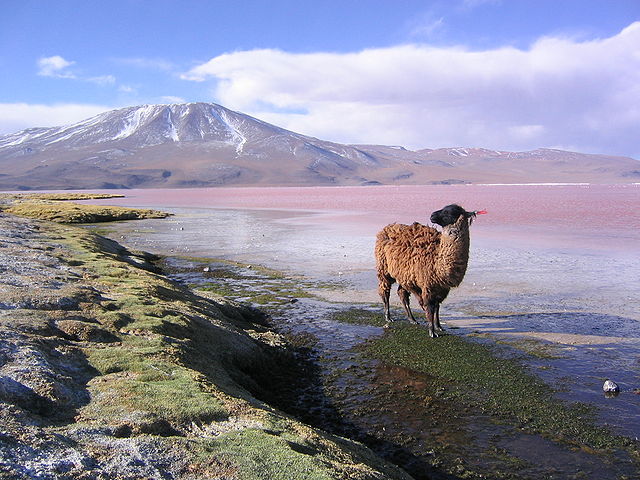Salar de Uyuni in the Bolivian Andes, the world’s largest salt flat, is an other-worldly experience that has to be seen to be believed.
Uyuni, Colchani
The antique train cemetery is located 3 km outside Uyuni and is connected to it by the old train tracks. The town served in the past as a distribution hub for the trains carrying minerals on their way to the Pacific Ocean ports. The train lines were built by British engineers who arrived near the end of the 19th century and formed a sizable community in Uyuni. The rail construction started in 1888 and ended in 1892. In the 1940s, the mining industry collapsed, partly due to the mineral depletion. Many trains were abandoned thereby producing the train cemetery.
Colchani is a small town near Uyuni, local families process the salt by drying, grounding and adding iodine. Salar de Uyuni is the world's largest salt flat at 10,582 square kilometers (4,086 sq mi). It is located near the crest of the Andes and is at an altitude of 3,656 meters (11,995 ft) above sea level. The Salar was formed as a result of transformations between several prehistoric lakes. It is covered by a few meters of salt crust, which has an extraordinary flatness. The Salar serves as the major transport route across the Bolivian Altiplano and is a major breeding ground for several species of flamingos.
Isla Incahuasi is a hilly and rocky outcrop of land and former island in the middle of Salar de Uyuni, the world's largest salt flat, at an elevation of 3,656 meters (11,995 feet). Isla Incahuasi is the Spanish name where isla means island, Inca stands for Inca, and huasi is derived from the Quechua word wasi meaning house. Incahuasi has a total area of 24.62 hectares (61 acres) and hosts gigantic cacti and a tourist center. The place is the top of the remains of an ancient volcano, which was submerged when the area was part of a giant prehistoric lake, roughly 40,000 years ago.
Uyuni
Chiguana, Nor Lipez, Sur Lipez
Head south into the desert expedition part of the adventure. Passing through the towns of San Juan and Chiguana military post you will enter the desert of Siloli. The desert has many geomorphological formations. It is one of the gateways to the Eduardo Avaroa Andean Fauna National Reserve, and often part of many adventure routes.
Laguna Hedionda is a saline lake. It is notable for various migratory species of pink and white flamingos. It lies at an altitude of 4,121 metres (13,520 ft), with an area of 3 square kilometres (1.2 sq mi). Salt flats and bofedales (wetlands) are spread over the periphery of the lake. It is in a very remote area where human habitation is negligible. However, llamas and alpacas are seen grazing in the area.
Arbol de Piedra is an isolated rock formation in the Eduardo Avaroa Andean Fauna National Reserve. Much photographed, it projects out of the altiplano sand dunes of Siloli, about 18 kilometres (11 mi) north of Laguna Colorada. Known as the "Stone Tree," it is shaped like a stunted tree about 7 m high. Its shape, particularly the thin stem, are due to strong winds carrying sand and eroding the soft sandstone.
Laguna Colorada (Red Lagoon) is a shallow salt lake in the Eduardo Avaroa Andean Fauna National Reserve and close to the border with Chile. The lake contains borax islands, whose white color contrasts with the reddish color of its waters, which is caused by red sediments and pigmentation of some algae.
Sur Lipez
Sol de Manana, meaning Morning Sun in Spanish, is a geothermal field. It extends over 10 square kilometres. The area is characterized by geothermal activity with many geysers and mud pools. Geysers emit jets of steam and hot water to a height of between 10 m (33 ft) and 50 m (164 ft) in the morning.
Laguna Verde (Spanish for "green lake") is a salt lake in and endorheic basin, in the southwestern Altiplano. It is close to the Chilean border, at the foot of the volcano Licancabur. It has mineral suspensions of arsenic and other minerals which renders colour to the lake waters. Its color varies from turquoise to dark emerald depending on the disturbance caused to sediments in the lake by winds.
Laguna Blanca is located beside Laguna Verde, only a narrow corridor separates it from the smaller Laguna Verde. The characteristic white colour of the water, that gave the lake its name, is caused by the high amount of minerals suspended in it. Typically, after visiting Laguna Verde and Laguna Blanca, next stop is the border transfer for travelers heading to Chile, or return to Uyuni with a stop for lunch.











